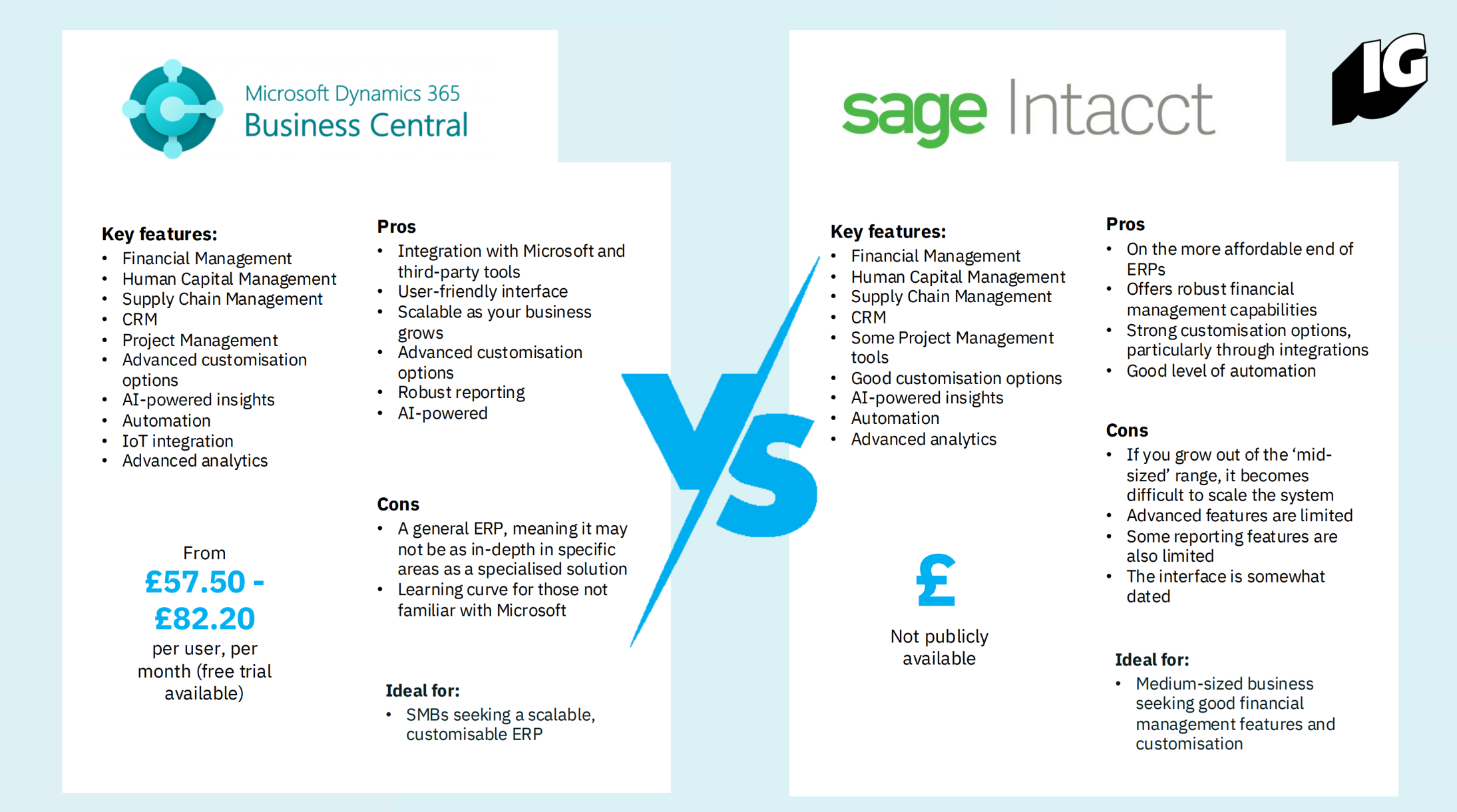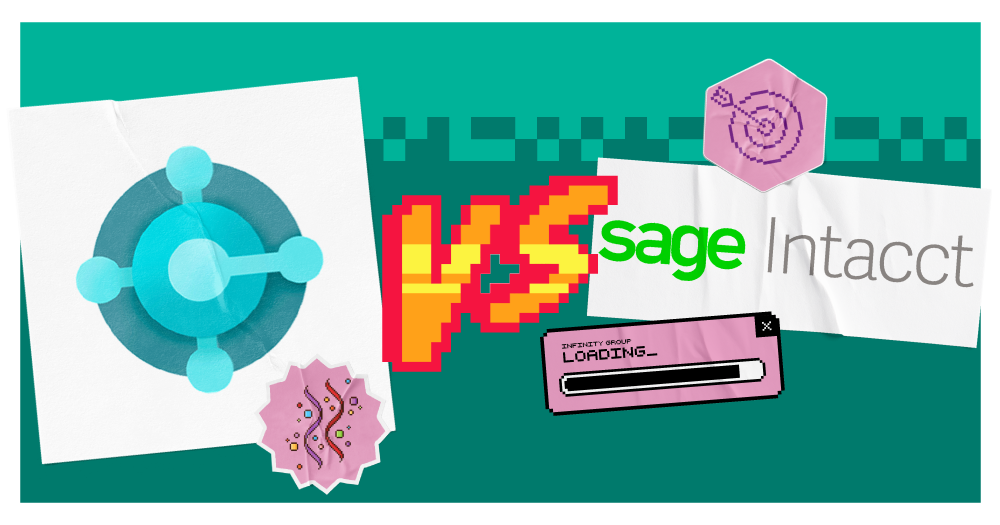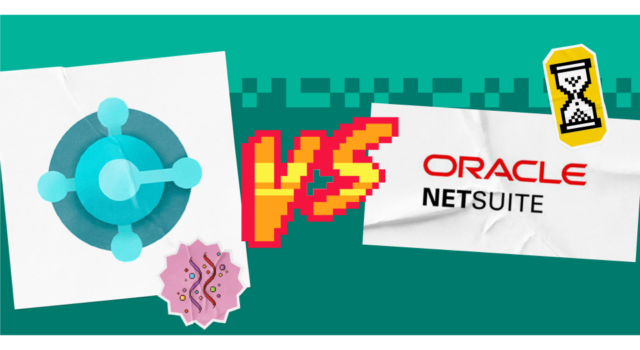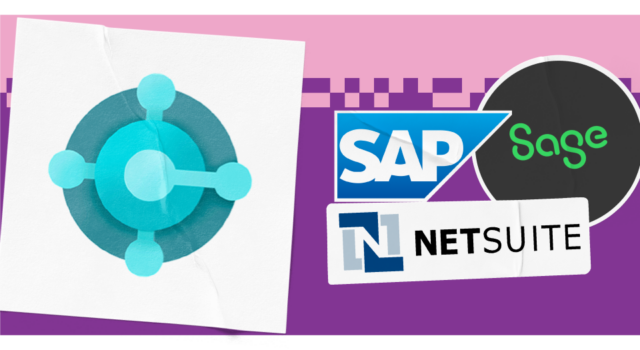Your all-important back-office operations, like finance, supply chain and business process, are crucial to daily performance. So, it’s natural that you need them underpinned by an ERP system that makes it easier to manage.
Due to this, choosing the right ERP for your business is essential for long-term performance. The best systems can help your business improve cost efficiencies, ward off the competition and boost productivity. And by choosing the right system now, you can prevent the need for future change projects once you outgrow your ERP.
Microsoft Dynamics 365 Business Central and Sage Intacct are two of the market leaders when it comes to ERP – but which should you choose? This comparison guide will help you answer that very question.
Sage Intacct vs Business Central: an overview
Let’s start with a quick glance at both Business Central and Sage Intacct.

Business Central
Dynamics 365 Business Central is a comprehensive cloud-based ERP systems on the market. It’s the current leader in the market, chosen by many familiar organisations, with a market share of 49%. Forbes even named it as the ‘best overall ERP’ system.
Business Central was created for small to medium businesses, offering all the tools you need to effectively manage your ERP. It’s also ideal for businesses using other Microsoft solutions, due to the advanced integration available across tech stacks.
Key features include:
- Finance management features (general ledger, accounts receivable and payable, cash flow management, fixed assets and more)
- Accounting functionality (including WIP and revenue recognition methods to ensure compliance and easy auditing)
- Sales order processing, quote and service management
- Inventory management (stock tracking, purchase order management and warehouse management)
- HR features (such as employee information, hours, payroll and performance management)
- Reporting and analytics
- Point of sale, inventory management and customer loyalty programs for retail
- Project management (as a fully integrated module, which includes project manufacture)
Sage Intacct
Sage Intacct is also a cloud-based ERP solution, which is one of the better-known systems on the market. It’s designed for mid-sized businesses, offering the capabilities they need for effective ERP management with a particular emphasis on finance.
Key features include:
- Core financials (general ledger, accounts payable, accounts receivable and cash management)
- Advanced reporting and dashboards
- Multi-entity and global consolidations
- Revenue recognition
- Project accounting
How do the costs compare?
When it comes to cost, Business Central starts at £57.50 per user, per month. There is a premium package priced at £82.20 per user, per month, which will give you access to absolutely everything the platform has to offer. Our guide explains licensing in even more detail.
Business Central is generally considered one of the most affordable ERP systems on the market, given the broad functionality available. There is also a one-month free trial option available.
Like Business Central, Sage Intacct is subscription-based. However, the prices are customised, based on the size of the business and complexity required. While prices are not publicly available, it’s seen as a more expensive system. There is no free trial available.
Business Central vs Intacct: strengths and weaknesses
Now, let’s examine the pros and cons of both Business Central and Sage Intacct in more detail.
Breadth of functionality
Business Central is known for offering a broad range of modules beyond finance, including strong capabilities in supply chain management, sales (basic CRM), project management, service management and even manufacturing in some versions. This makes it a more integrated solution for businesses needing to manage multiple operational areas.
Compared to this, Sage Intacct is a lot less broad, with most features focusing on finance.
However, the features in this area are comprehensive, providing deep and sophisticated cloud accounting and financial management capabilities. This includes areas like general ledger, accounts payable/receivable, cash management, consolidation, intercompany transactions and global operations. Intacct is also known for its advanced features for managing complex subscription models, recurring revenue and billing schedules. This means it may be the best option for businesses looking for an in-depth finance system – and nothing beyond this.
Scalability
Business Central is highly flexible. With a subscription-based pricing model, it’s easy to add on new users as teams grow. You’ll only need to pay the cost of additional licenses, meaning no steep increase in price.
Due to the modular design of the platform, it’s also easy to implement new features as your business needs evolve, as core functions.
Intacct offers a similar sense of scalability, but only within the finance function. Users can easily be added, and there is the option to add and manage multiple business entities. However, it’s also been reported that Intacct is only suitable while you stay within the ‘midsize’ category – at which point you may need to implement a new system.
Customisation and integration
Business Central offers significant customisation options through extensions, the Power Platform and development tools, allowing businesses to tailor the system to their specific workflows and reporting needs. APIs also allow you to connect to third-party tools.
It particularly excels when it comes to integration with other Microsoft solutions. If you use the likes of Outlook, Teams or any of the Office applications, contextual insights can be shared from Business Central, giving you the right information wherever you’re working. This also prevents you from having to manual input information across multiple locations.
While not native to a broad ecosystem like Microsoft, Intacct also offers robust integration capabilities through APIs and a marketplace of third-party applications focused on finance and related areas.
However, customisation options are lacking beyond this. Options are primarily focused on financial reporting and dashboards, making it harder to integrate with tools covering other areas or extend capabilities.
User friendliness
Business Central has a modern and intuitive interface consistent with other Microsoft products. If your business already uses Microsoft tools, it’ll be easier for people to get used to Business Central as that familiarity will be in place.
For system admins, there are plenty of tools available to help you easily manage Business Central too. Plus, Microsoft offer a massive range of resources to train users, answer common questions and show you how to achieve specific tasks.
Intacct is also generally praised for its intuitive and well-designed user interface. However, some users have noted that while the core functionalities are user-friendly, certain advanced customisations or specific modules might have a steeper learning curve or require some technical understanding. People with experience in similar financial systems are likely to pick it up faster.
Deployment
Business Central offers a variety of deployment options, including cloud-based, hybrid or on-premises. This allows businesses to choose a deployment option that works for their specific needs and infrastructure.
Intacct, on the other hand, only offers cloud-based deployment. While this will be suitable for most businesses, it may limit some organisations.
Data and reporting
When it comes to data, Business Central offers a more unified and broader approach due to its ERP nature. It centralises financial, operational (like sales and inventory) and customer data within a single database, providing a holistic view of the business.
It can then turn these data in reports, leveraging its comprehensive and user-friendly data accessibility. There are several pre-made templates you can utilise, which can be tailored, or you can build custom reports from scratch. These can be seamlessly enhanced through powerful integrations with Microsoft Excel and Power BI for deeper analysis and insightful visualisations.
However, more complex reports may require advanced skills to create.
In contrast, Intacct excels in the depth of its financial data management. Its dimensional accounting structure allows for granular tagging and analysis of financial transactions, offering superior financial reporting capabilities. While it integrates with other systems via APIs and a marketplace, it primarily acts as a central financial data hub.
AI
Business Central leverages its deep integration with the Microsoft ecosystem to embed AI across various ERP functions. Features, powered by Microsoft Copilot and Azure AI, assist with content generation for sales, forecasting for inventory and cash flow, bank reconciliation and even image analysis for enhanced data entry.
This broad application of AI aims to optimise workflows and provide intelligent insights across sales, supply chain, finance and basic marketing, making it a versatile platform for businesses seeking AI-driven improvements across multiple operational areas.
Intacct also leverages AI to enhance its core financial management capabilities. Its AI-powered features focus on automating accounts payable processes, detecting anomalies in the general ledger, streamlining expense management and providing intelligent financial assistance. This AI is useful for your finance functions, but doesn’t extend beyond this or integrate with your other tools like Microsoft’s does.
Automation
Business Central offers a wider scope of automation capabilities stemming from its broader ERP functionality. It allows for the automation of processes across various business areas, including sales order processing, purchase order creation, inventory management workflows and even basic marketing tasks.
Its integration with Power Automate provides a powerful platform for building custom workflows and automating tasks that span across different modules and even external applications within the Microsoft ecosystem. This makes Business Central suitable for businesses looking to streamline end-to-end processes across their operations.
Sage Intacct offers automation primarily focused within the accounting and finance functions. This includes automating tasks like invoice processing, payment reminders, bank reconciliation, and recurring journal entries. Its strength lies in automating complex financial workflows, particularly around multi-entity consolidations, revenue recognition and subscription billing.
This means the automation within Business Central is more far-reaching.
Value for money
Business Central offers great return on investment. While initial implementation costs can vary, the comprehensive nature of the system can reduce the need for separate systems, potentially lowering the overall cost.
The customisation options also mean Business Central can adapt with your business, allowing evergreen value and preventing the need for new systems.
Intacct offers less value for money, due to the customisation options being focused on financials rather than the wider business. However, if that is what your business needs, it could still provide you value.
The bottom line
It’s clear that, while they’re both well-regarded ERP systems, there are crucial differences between Business Central and Sage Intacct. So, which is right for your business?
If you need a comprehensive ERP system, with strong financials and seamless integration, Business Central is the best solution. This is particularly true for businesses who already use the Microsoft ecosystem, so will benefit from the advanced integration. with the Microsoft ecosystem. It’s also ideal for those who want to leverage powerful customisation, AI and automation across core business areas, or if you’re working to a budget.
If your focus is on in-depth financial management and accounting, and you already have tools in place to support other back-office operations, Intacct is your options. This will be suitable for those with complex financial needs like multi-entity consolidations, advanced reporting or sophisticated subscription billing.
Ultimately, the best choice depends on your specific needs, priorities, budget and existing technology infrastructure. So, spend time thinking about what matters most.
Our consultants are also available to discuss how Business Central can fit your needs and answer specific questions to help you understand whether it’s the right choice for your business.
Or if you’d like to know how Business Central and Intacct stack up against even more ERP solutions, check out our in-depth comparison guide.




